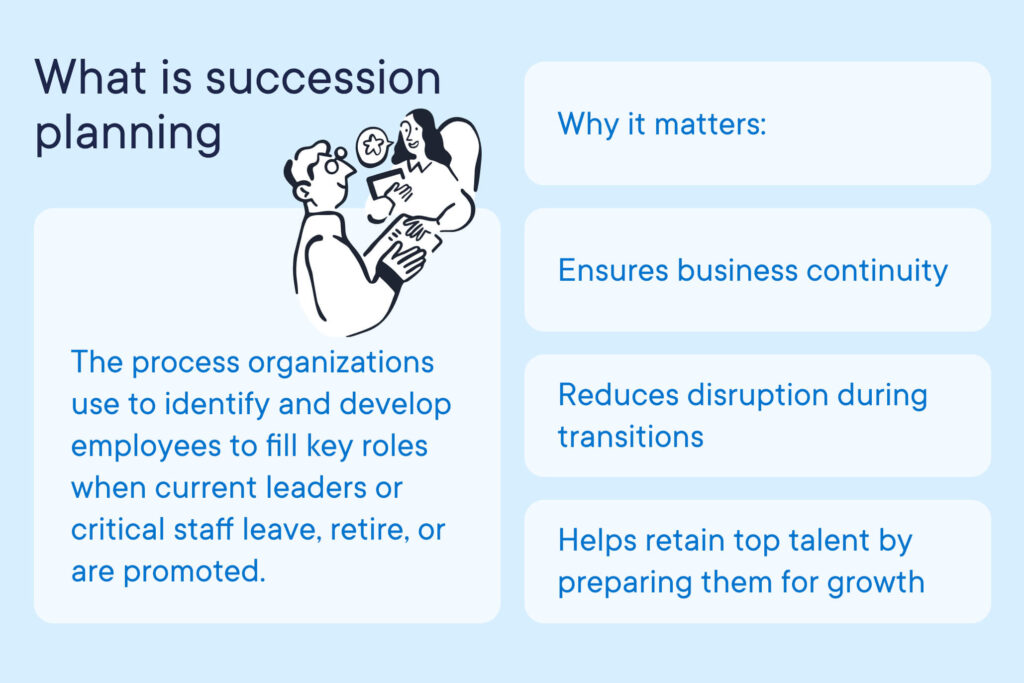
The 5-Step Succession Planning Process Every HR Team Needs
November 30, 2025 Written by Cynthia Orduña

Compare Providers
Download our outplacement comparison sheet
Request Pricing
Compare our rates to other providers
When employees leave your organization, you need to have a plan to retain all of the knowledge that they have gained over the course of their tenure. This means having a plan for another employee to seamlessly step into the role and keep your business marching forward.
This process is known as succession planning, and it’s more important now than ever.
But what is succession planning in HR and how do you start implementing a succession planning process? What do you need to know for your plan to be successful?
In this article, we’ve created a complete guide to succession planning strategies. You’ll learn what succession planning is and why it’s important, the five essential steps involved, and the tools you’ll need to get started with your own plan.
What Is Succession Planning?
Succession planning is a process that focuses on the development of new leaders in an organization so that they’re ready to take over leadership roles when current leaders leave the organization.
In other words, succession planning is a way to ensure that your organization experiences little to no loss of knowledge or progress through talent transitions. When one leader steps down, another should be ready to step into the role, allowing business to continue smoothly.

What Is an Example of Succession Planning?
Let’s explore this definition further with a succession planning example to get a clearer picture of what succession planning is and why it is so important.
The Problem
If, for example, you neglect the development of your future leaders, you could wind up with an empty senior role that you cannot fill internally. This forces you to look outside of the company to fill that leadership role, which can cost you much more time and money.
It’s also important to remember that succession planning isn’t only about older workers retiring. Although retirement planning is important, when it comes to knowledge transfer and talent retention, younger workers can often perform jobs that no one else in the organization can handle.
The Consequences
If one of your staff is working in a role that no one else has an understanding of or the skills to succeed in that role, you are setting yourself up for a talent gap if that staff member ever leaves.
The Solution
To avoid this scenario, it is vital that you identify the crucial skills, knowledge, and organizational practices necessary for the role in question, and create a process for passing them on to prepare your next generation of leaders. This will ensure the seamless movement of talent within your organization.
Succession planning involves taking a deep look into what your company values, what knowledge is most important for your business to retain, and what skills learned over the course of your employees’ career paths are hard to replace.
Once those key areas are identified, your company can start taking steps to ensure that those skills are not lost when employees leave your organization. It’s a way of future-proofing your organization, making sure that it can continue running even after turnovers take place.
Looking for the right partner to help you achieve this? Click below to connect with our Careerminds experts and learn more about our modern, results-driven solutions for workforce and succession planning, leadership coaching, and talent development that will elevate and fortify your entire organization.
What Are the 5 Steps of Succession Planning?
Let’s take a deeper look into what it takes to start the succession planning process. Remember, you first need to identify what skills, knowledge, and roles you need to retain.
- Is there a process that is super unique to your company?
- Are there leaders who’ve worked in their position for a long time and know the ins and outs of every task?
- Can you identify leaders working in roles that will be hard to fill once they leave?
Chances are you can identify areas like these across all the levels of your organization, from your senior leadership down to individual contributors.
Once you’ve taken a step back and looked at the talent inside your company, you need to create the actual plan to retain that talent. A succession plan can be viewed as a series of events that happen over the course of the employee lifecycle. Here are the five events you need to focus on to cover the essential succession planning steps.
Step 1: Onboarding and Training
The succession planning process starts at the very beginning of the employee lifecycle, and encompasses everything that will happen during an employee’s time at your company. This first step entails covering all of the tasks the employee will have to do in their new role, and testing to see what talents they’ve already mastered versus ones they may need to develop further.
What does this have to do with succession planning? For starters, it helps you figure out where your existing talent pool is lacking and what skills in your organization need to be strengthened so that, if someone should leave, you can have someone else ready and able to take their place.
So the onboarding process is about more than paperwork and preparing the employee to start working. It should be a thorough and cohesive process that involves all levels of your organization to ensure an optimal onboarding experience that is merely the first step of your talent development plan.
By paying close attention to the talents of your hired staff as they onboard into their new roles, you can be better prepared for the future. Who knows, the person you just hired may stay with your organization for decades. They may be one of your next leaders someday.
Step 2: Leadership Development
Leadership development is a continuous process that starts as soon as the employee begins a new role and continues throughout their tenure with your company. It’s vital to offer workers ways to improve their skills because doing so will engage your staff, help retain them for longer, and greatly improve your business practices overall.
After onboarding is complete, it can be easy to let employees go about doing their day-to-day tasks without paying attention to the bigger picture. While doing quality work every day is important and has its own challenges, those daily tasks should also be coupled with opportunities for employees to improve. In order to have leaders primed to take over vacated roles, your organization needs to develop and prepare them to do so.
Many CEOs claim that their most important task is identifying and grooming future leaders to ensure the continued success of their companies. Every company faces turnover, so every company will need leaders and workers who can step up to perform more advanced tasks when needed.
If you can create a culture of continued learning in your organization, you can ensure that your staff will progress through their careers and eventually be able to take on more senior roles. Essentially, continuous leadership development is a way of ensuring that succession planning continues to unfold at a smooth pace.
At Careerminds, we specialize in leadership coaching programs that help emerging and senior leaders harness their strengths and lead with confidence. Click below to speak with our experts and learn more about our leadership development solutions.
Step 3: Career Development
It’s equally important to develop both your staff’s professional skills and personal career goals. While it can be easy to neglect a worker’s personal career ambitions, this can prove detrimental to your succession planning.
So iIt’s important to keep an open dialogue with employees to understand what motivates them, what will retain them, and what they want to achieve in their career. Workers will be more likely to stay with your organization when you show your support for their personal and professional goals.
In an effort to retain staff, organizations often offer a wide variety of perks that can entertain more than they engage. However, these types of benefits may not last as long as they seem. One of the best and longest lasting benefits a company can offer its staff is ways to continue their personal and professional development.
Some companies may see this as a negative, fearing that it will entice employees to leave the organization once they gain new skills. However, this is a largely unfounded worry. Of course, providing great career development to your staff means that some people will naturally grow out of the role they were hired for.
So part of this step also involves making sure that you are providing new projects and challenges to employees who want to try something new, even if they don’t fully align with their day-to-day tasks.
This is all about retention, which is especially important for rapidly growing companies who often subsequently face a higher turnover rate. If you offer ways for your workers to continue growing along with the business, you are far more likely to retain them.
The key is providing a path for continued learning in your organization that allows your staff members to develop their talents and use them where they are applicable and valued, creating a positive and promising work environment that encourages them to stay put.
This in turn allows you to maximize your workforce planning to ensure that you are always using your available talent where they are needed most.
Step 4: Workforce Planning
This step is all about making sure that your talent resources align with your business needs. Workforce planning is essentially the process of identifying your business goals and the allocation of talent and personnel you will need to achieve them.
Companies that are proactive about their workforce planning have a huge competitive advantage over those that aren’t. Workforce planning allows you to stay nimble while developing the right talent for the right job.
While that might seem simple enough, this is a step that organizations commonly overlook or forget to do. Maybe they don’t know how to get started, or don’t have a clear guide to follow, and keep putting it off in favor of more pressing daily tasks. Whatever the reason, this step is a crucial part of the succession planning process to help your organization continue running smoothly.
This begins with devising a strategic workforce plan that will best position your organization to meet its business goals. This requires input and collaboration from HR, recruitment, finance, and business analytics. The key to running your business smoothly is to be aligned and organized.
Having a solid workforce plan in place will enable better business forecasting and problem solving, strengthen your leadership development strategy, and help everyone achieve more success across the organization.
In a way, succession planning is just one part of your larger workforce plan. It goes beyond preparing your staff to smoothly step into different roles to also encompass finding, training, and retaining the right talent for your business needs.
So it stands to reason that workforce planning is a necessary part of successful succession planning. The goals of both center around ensuring that the right people are in the right roles for themselves and the organization.
Where they differ is in their scope and timeline. Workforce planning focuses on the more immediate situation, ensuring that current business needs are always being met, and is therefore more budget and staffing driven.
If you need more guidance on devising a strategic workforce plan for your organization, click below to download our free Careerminds workforce planning guide that will walk you through the entire process from start to finish.
Succession planning, on the other hand, is more focused on the future, using hiring forecasts and internal resource projections to identify what roles may need to be filled and how to prepare successors for them.
Step 5: Proactive Exit Planning
To round out the succession planning process, it’s important to understand the full employee lifecycle from onboarding to offboarding. The employee exit is the last part of that cycle, and is once again a crucial part of your succession planning strategy.
This step is often referred to as replacement planning. You want to make sure that you have a plan ready to replace talented individuals—whether they are younger or older workers—when they leave your organization.
This is typically what people think of when they hear “succession planning.” And while succession planning in HR starts long before offboarding comes into play, this last step in the employee lifecycle is the crucial final piece of the succession planning puzzle.
The mark of a true leader is someone focused not only on growing themselves, but also growing others around and under them. As we mentioned earlier, many CEOs consider a big part of their role to be identifying and preparing people who will take over for them and other senior staff when they exit.
While succession planning isn’t only applicable at the C-level, it can be beneficial to examine how companies identify, develop, and transition in new CEOs and top-level executives. This will give you additional insight into what a strong succession planning template looks like at its core.
When dealing with high-level succession planning, or indeed any level of succession planning, here are a few key tips that will help you succeed:
- Engage stakeholders: Identifying areas for succession planning should involve key company stakeholders, current leaders, and HR together. The more input you have, the better you’ll likely be at finding a proper replacement.
- Assess internal candidates: If you’ve been grooming future leaders in your organization, look at which ones would fit the soon-to-be vacated role. Decide whether hiring outside of the company will be necessary.
- Conduct tests: There’s no better way to see if a future leader is up for the challenge than to test them. This could include giving them special projects, internships or training programs, the DiSC leadership assessment, or other tests designed to gauge their abilities in the short and long term.
- Onboard the successor: This can be the most underserved part of the process. However, succession planning doesn’t end once the new leader is brought on. This is where the employee lifecycle begins anew, and we come back around to the importance of onboarding and development.
The key is to look inside your company, conduct an honest examination of which leaders are ready to move up, bring in as many eyes as possible to ensure that you’re making the right choice, and then onboard and develop them properly in their new role.
This can be applied to every level of your organization. For example, say you have a senior staff member in a valuable role who is looking at retirement. This person may not be in your C-suite, but does have a plethora of knowledge you need to retain to keep your organization marching forward.
This role needs a succession plan. Without one, you will not be able to retain that knowledge, creating a disadvantage for your business and the rest of your staff.
For this succession planning example, follow similar steps from the CEO example above to ensure that your impending talent gap is successfully filled. If possible, this can involve having the impending retiree mentor their successor. It depends on your corporate culture and how well you’ve developed your internal talent to step into the senior role.
What Are the Best Tools for Succession Planning?
The core message here is that successful succession planning in HR means being proactive about planning your staff exits—at every level of the company—to ensure that you thoroughly evaluate, prepare, onboard, and develop your successive talent across their entire employee lifecycle to smoothly take over the reins when you need.
In order to do this, you may want to employ the use of some helpful succession planning templates, tools, and resources.
Talent Development Tools
For example, as you get into the leadership and career development steps, you might want to bring in outside experts who can implement strategies that fit your specific business needs. At Careerminds, we offer in-depth leadership coaching programs that will empower your leaders to harness their strengths, align their career aspirations with their values, and achieve a higher level of performance.
Workforce Planning Tools
At the workforce planning stage, there are a multitude of great workforce planning tools and models designed to help HR professionals with proactively planning and predicting your workforce needs, including our free comprehensive Guide to Workforce Planning.
Exit Planning Tools
Then, as you prepare your exit planning step, it can be helpful to follow an employee exit and offboarding checklist to be sure that you don’t miss anything. It’s also a good idea to outline a process for the exiting employee to mentor their incoming successor, especially for leadership roles.
Talent Assessment Tools
Remember that, for these higher-level roles, individuals should be identified and tested to see if they have potential for a more senior role. This process should involve every stakeholder across the organization to ensure success, as well as some key valuable tools to assist you with the identification and assessment.
This might include the DiSC leadership assessment mentioned earlier, or outside support from a specialized provider such as our Careerminds executive coaching solutions.
Whatever tools, tactics, and services you employ, make sure that they fit with your specific company values, business goals, and workforce concerns. It’s never too early to start thinking about your succession planning strategy, both to optimize your current workforce needs and prepare your organization to continue running smoothly when any valuable employees leave in the future.
Succession Planning: Final Takeaways
So what is succession planning in the end? It is a way for organizations to ensure that they have suitable leaders and talented staff members ready to take over the roles of departing employees when they exit.
Here are the key takeaways:
- Succession planning safeguards your organization’s future. It minimizes disruption by ensuring that the right people are ready to step into critical roles when needed.
- The succession process begins the moment a new employee joins your organization and is onboarded into their new role.
- Invest in leadership and career development to create stronger leaders and improve employee retention.
- Use workforce planning to stay proactive. Aligning talent with business goals helps your organization remain agile and competitive.
- Proactive exit planning, mentorship, and knowledge transfer keep operations running smoothly during leadership changes.
- Assessments, coaching programs, and workforce planning tools can help identify and develop your next generation of leaders.
By following a solid succession planning strategy, your business will be prepared when a senior staff member steps down for retirement, a new opportunity, or any other reason. It also helps you future-proof your business by forcing you to examine and plan your workforce needs in advance, making sure that talented individuals transfer their knowledge before they exit.
Want to learn more about succession planning? Partner with our team at Careerminds to build a tailored succession planning strategy that develops your leaders, retains key talent, and keeps your business moving forward. Click below to speak with our experts today.
In need of outplacement assistance?
At Careerminds, we care about people first. That’s why we offer personalized talent management solutions for every level at lower costs, globally.



